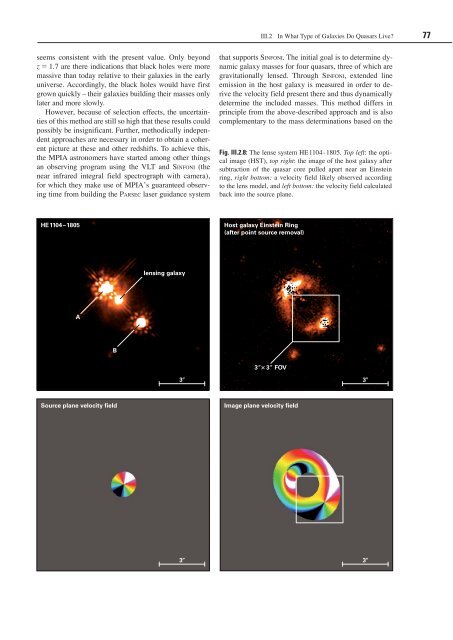Max Planck Institute for Astronomy - Annual Report 2007
Max Planck Institute for Astronomy - Annual Report 2007
Max Planck Institute for Astronomy - Annual Report 2007
You also want an ePaper? Increase the reach of your titles
YUMPU automatically turns print PDFs into web optimized ePapers that Google loves.
seems consistent with the present value. Only beyond<br />
z 1.7 are there indications that black holes were more<br />
massive than today relative to their galaxies in the early<br />
universe. Accordingly, the black holes would have first<br />
grown quickly – their galaxies building their masses only<br />
later and more slowly.<br />
However, because of selection effects, the uncertainties<br />
of this method are still so high that these results could<br />
possibly be insignificant. Further, methodically independent<br />
approaches are necessary in order to obtain a coherent<br />
picture at these and other redshifts. To achieve this,<br />
the MPIA astronomers have started among other things<br />
an observing program using the VLT and Si n F o n i (the<br />
near infrared integral field spectrograph with camera),<br />
<strong>for</strong> which they make use of MPIAʼs guaranteed observing<br />
time from building the pa r S e c laser guidance system<br />
HE1104–1805 Host galaxy Einstein Ring<br />
(after point source removal)<br />
A<br />
B<br />
lensing galaxy<br />
3<br />
III.2 In What Type of Galaxies Do Quasars III.X Live? Titel 77<br />
that supports Si n F o n i. The initial goal is to determine dynamic<br />
galaxy masses <strong>for</strong> four quasars, three of which are<br />
gravitationally lensed. Through Si n F o n i, extended line<br />
emission in the host galaxy is measured in order to derive<br />
the velocity field present there and thus dynamically<br />
determine the included masses. This method differs in<br />
principle from the above-described approach and is also<br />
complementary to the mass determinations based on the<br />
33 FOV<br />
Source plane velocity field Image plane velocity field<br />
Fig. III.2.8: The lense system HE1104-1805. Top left: the optical<br />
image (HST), top right: the image of the host galaxy after<br />
subtraction of the quasar core pulled apart near an Einstein<br />
ring, right bottom: a velocity field likely observed according<br />
to the lens model, and left bottom: the velocity field calculated<br />
back into the source plane.<br />
3 3<br />
3

















